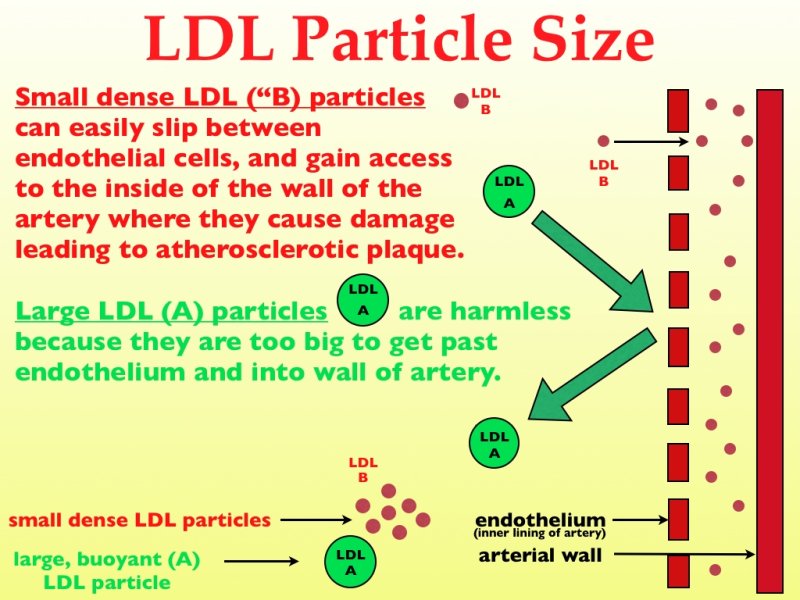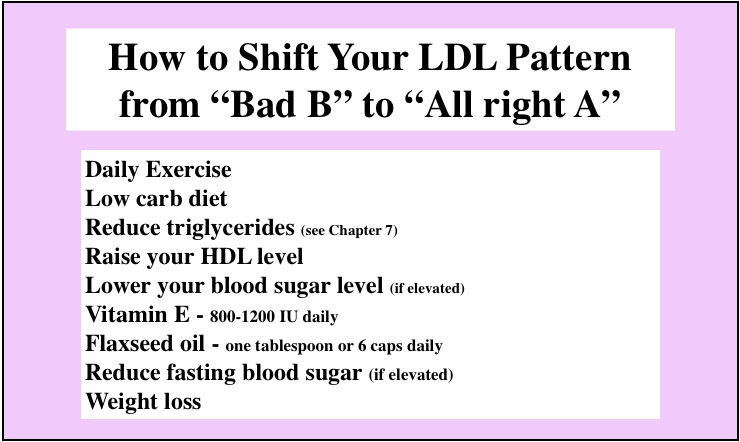
Superior Index Go to the next: Chapter 13
Print Files: A4 Size.
Small dense LDL ("B") particles can easily slip between endothelial cells, and gain access to the inside of the wall of the artery where they cause damage leading to atherosclerotic plaque.
Large LDL ("A") particles are harmless because they are too big to get past endothellium and into wall of artery.

Most people know that excess LDL particles - too much "bad cholesterol" - can cause heart attacks. Few appreciate, however, that LDLs come in different sizes, and that LDL particle size is intimately linked to risk. Specifically, larger LDL particles are relatively benign, while smaller LDLs spell danger.
In the 1980s, researchers began questioning the predictive accuracy of cholesterol and the lipid panel. It was no secret that 75 percent of patients with myocardial infarctions had normal LDL and HDL. In the landmark Framingham Study, 80 percent of the patients with a cardiovascular "event" had lipid levels identical to the population that was event-free. At best, only about 40 percent of premature cardiovascular disease can be accounted for by factors in the lipid panel. Clearly, a more precise version of the lipid panel was necessary.
In 1988, scientists led by Dr. Ronald M. Krauss, head of the Department of Molecular Medicine at the University of California's Lawrence Berkeley Laboratory, first established a link between smaller, denser LDL particles and the subsequent development of heart disease. Dr. Krauss's paper says, "The LDL subclass pattern characterized by a preponderance of small, dense LDL particles was significantly associated with a threefold increased risk of myocardial infarction."
In his presentation at the American Heart Association's 67th Scientific Sessions in Dallas, Dr. Krause said, "Since heart attacks often occur in people whose total cholesterol levels put them at only moderate risk - those with readings in the 200-240 mg/dl range - it is hard to pick out the person who's going to get heart disease. That's why it is important to look at other factors such as LDL that might aid in that prediction."
You bet. Turns out there's a tight relationship between the diameter of an LDL particle and cardiovascular risk. For every nanometer (nm; one billionth of a meter) decrease in LDL particle size, cardiovascular risk increases by 200 percent. Think of it: a decrease in size of your LDL particles of one billionth of a meter more than doubles your risk of a heart attack or stroke! Whoa.
Why is LDL size so important? How can a billionth of a meter of anything spell the difference between life and death? Though it may not be true in other aspects of life, down in the nanoscale world of LDL particles, bigger really is better. Smaller, denser LDLs can easily slip through the small space between endothelial cells and thus gain access to the inside of the arterial wall where they initiate plaque. Meanwhile, their larger, less dense fellow travelers are denied access simply because they are too big to wiggle through.
It helps to think in terms of beach balls and bullets here. Large sized LDL particles (the beach balls) ricochet harmlessly off the arterial wall, while small LDL (the bullets) penetrate the artery's endothelium and start causing trouble.
Your endothelium (that single layer of flat, skin-like cells that line the inside of your blood vessels) provides a protective wall that blocks entry of larger LDL particles into the arterial wall. A healthy endothelium does a good job of protecting the artery below from unwanted items. If the endothelium becomes inflamed, however, it is unable to stop the smaller LDLs from breaking through the barrier - and when this happens, molecular mayhem ensues, leading directly to atherosclerotic plaque, heart attacks, and strokes.
What is the actual size difference between those denied access and those allowed in? For me, this is where things get surreal. That difference would be 0.7 nanometers, slightly less than a billionth of a meter, a value so small that non-physicists may have trouble grasping it. What kind of lilliputian laws give seven-tenths of a nanometer the power to decide between life and death? If this doesn't kindle a newfound awe and respect for the colossal power and leverage of cellular and sub-cellular molecular events, I don't know what would.
LDLs average about 25 to 26 nanometers (nm; billionths of a meter) in diameter. To get an idea of just how small LDL particles are, consider this: you'd have to line up ten million of them side by side to make a line just an inch long. Clinical pathologists classify LDL particles into two main groups: large ("Pattern A") and small (Pattern "B"). The large LDLs of "Pattern A" are greater than 25.7 nm in diameter. Small, dense LDLs, those in "Pattern B," have diameters less than 26.4 nm. (Intermediate sized LDL particles range between 25.8-26.3 nm.)
Individuals with large LDL ("Pattern A") particles are at significantly lower risk of atherosclerotic disease. Conversely, people with small dense (Pattern "B") LDL particles are at greatly increased risk of atherosclerotic disease.
(I was having a hard time remembering which type was desirable and which not, so I came up with this arbitrary mnemonic device: "A" stands for "All right" and "B" stands for "Bad". This may seem a bit hokey, but it works for me.)
There is another reason you want the large fluffy "A" type particles: Small, dense, "bad" "B" LDLs are more vulnerable to oxidation than their larger, healthier compatriots. Smaller particles have a greater surface area to mass ratio, and thus provide a bigger target for oxidizing agents. This provides yet another reason for taking daily doses of antioxidants like phytonutrients, alpha lipoic acid (100-600 mg/day), vitamin E (as mixed tocopherols, 400-2000 IU/day), vitamin C (2000-10,000 mg/day), coenzyme Q-10 (as Coenzyme QH, the reduced form, 50-300 mg/day), and carotenoids (as mixed carotenoids 10,000 IU/day). By protecting LDL from oxidation, these nutritional medicines lower the risk of heart disease.
Don't confuse LDL particle number (which is part of the Lipid Panel) with LDL particle size (a different test, also called a "VAP"). They are two completely different markers for cardiovascular risk. LDL is a type of particle called LDL (HDL and VLDL would be examples of other particle types.) LDL particle size measures the actual diameter of your LDL particles; the lab result is actually a distribution of the various sizes of all your LDL particles.
Simply having a high LDL doesn't mean one is doomed to have more of the small bad "B" type. Conversely, a low LDL doesn't imply an "A Pattern". Studies have shown, however, that people with more of the undesirable "B" type are more likely to be males, more likely to have elevated triglycerides and elevated apolipoprotein (a), and more likely to have less HDL ("good") cholesterol) level.
Studies also show that people with a high cholesterol and small dense ("B" type) LDLs appear to receive more benefit from cholesterol lowering treatment than those with a high cholesterol and large ("A" type) LDLs.
Small, dense Pattern "B" LDL particles are also more prevalent in persons with the pre-diabetic metabolic (insulin resistance) syndrome. Treating an elevated blood sugar and reversing the metabolic syndrome (see Chapter 10) will shift the pattern away from "B" and toward preferable Pattern "A".
So how can you determine whether your LDL particles are bouncing beach balls or deadly bullets? Get tested. There are three different techniques for measuring particle size. Berkeley HeartLab Inc. offers an LDL gradient gel electrophoresis. LipoScience Inc. offers a nuclear magnetic resonance (NMR) method; and Atherotec Inc. uses their vertical auto profile (VAP) test. The results for all three are comparable.
The results printout provides a bunch of confusing data about various types of particles, but all you need to do is locate the summary that tells you whether your particles are predominantly small ("Pattern B") or big ("Pattern A"). You might be somewhere in between these extremes; this is call "Mixed Type". The printout usually looks something like this:

Triglyceride lowering treatments create large fluffy LDLs. HDL elevating treatments create large fluffy LDLs. You can use this information to save money on LDL particle size retesting. If, on initial testing, your LDL particle size turned out to be Type "B," you can track your treatment program progress by following the (less expensive) HDL and triglyceride levels on your lipid panel. If your HDL was low and is now coming up, and if your TG was high and is now coming down, you can safely assume your program is also working to increase your LDL particle size.

Reduce triglycerides (see Chapter 7)
Lower your blood sugar level (if elevated)
Flaxseed oil - one tablespoon or 6 caps daily
Reduce fasting blood sugar (if elevated)
Want to trade your bullets in for beach balls? By now this must seem like a broken record, but here I go again: carbohydrate restriction, daily exercise (and the weight loss they generate) dramatically enhance conversion of small dense LDL to bigger, softer, fluffier Type "A" LDL particles. (See Chapter 11.)
All triglyceride-lowering therapies (such as low carb dieting) also shift LDL particle size toward the large fluffy type "A".
The same diet and exercise prescriptions that successfully manage lipid abnormalities (by this I mean lower your cholesterol, LDL and triglycerides, and raise HDL) will also shift the size of LDL particles toward the beneficial large buoyant type. You already know the drill: daily exercise (at least one hour), weight loss (it'll come naturally with daily aerobic exercise), no processed foods, mostly organic foods, no refined sugars, and dietary restriction of animal fats and carbs. Avoid fatty dairy products and fatty meats. Replace saturated fat with plant-derived monounsaturated fats, such as coconut, palm, olive, flaxseed, or walnut oil.
See Chapter 7: The Lipid Panel.
The same diet and exercise prescriptions that successfully raise HDL will also shift the size of LDL particles toward the beneficial large buoyant type.
If your fasting glucose is over 90, treat insulin resistance (see Chapter 11). Without fixing the blood sugar regulation problem, the LDL particle size will not revert to normal. With blood sugar control, however, LDL particle size will move in the desired direction (i.e., larger). Raising your LDL particle size provides yet another reason to give up that sedentary lifestyle, avoid the sugars and animal fats, and eat low carb.
Replace saturated fat with plant-derived monounsaturated fats, such as olive or coconut oil.
* I don't recommend taking these; they are included for informational purposes only.